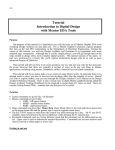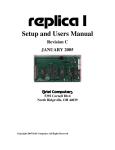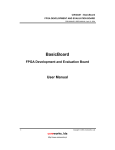Download User Manual for Digital Logic Trainer Kit
Transcript
User Manual for Digital Logic Trainer Kit 1. Introduction Figure 1 shows a close up of the logic trainer PCB (printed circuit board) you will use as an introduction to designing combinational and sequential logic circuits. The training board has a variety of basic gates and larger devices built on and pre‐wired to the connectors of the board. To indicate pre‐wired devices, schematic symbols have been silk‐screened onto the board and show which connectors serve as the inputs and outputs. These devices can be wired together to create a custom circuit. Figure 1 ‐ Digital Trainer Board (PCB) 2. Board Components The board components indicated on the figure are described below. A. DC adapter: The adapter is used to provide the power supply to the board. Each gate of each chip needs to be supplied with power (logic ‘1’ voltage) and ground (logic ‘0’ voltage) to be able to correctly operate. B. Logic IC’s: These chips contain the actual gates/circuitry. The inputs and outputs of the gates are then wired via the PCB (printed circuit board) to the connectors. a.) Logic IC ‐ A small notch on the package indicates the top and pin 1 will be to its left. b.) Schematic diagram of a 74LS00 quad NAND gate IC Figure 2 ‐ Logic IC's and Schematics C. Vdd and Vss: Vdd is the name given to the high voltage Vdd (5 or 3.3V) value representing logic ‘1’. You may use these Vdd connections as constant ‘1’ inputs to a gate if needed. Vss Logic ‘1’ Range is the name given to the low voltage value representing logic ‘0’. You may use these Vss connections as constant Undefined ‘0’ inputs to a gate. Logic ‘0’ Range Note 1: If Vss = 0V then it is the same as Ground or GND Vss / GND (0V) Note 2: Logic gates will optimally output Vdd for ‘1’ and GND for ‘0’ but often output a lower voltage than Vdd or higher voltage than GND (anything within the allowed ranges of logic ‘1’ or ‘0’). D. Toggle Switches: These four switches can be used as inputs to gates. However, the polarity of the switches is reverse from normal intuition. A switch in the “on” position yields a logic ‘0’ and the switch in the “off” position yields a logic ‘1’. Figure 3 ‐ Toggle Switch Configuration Switch open/off = Logic ‘1’, Switch closed/on = Logic ‘0’ E. Pushbuttons: These 4 pushbuttons can be connected to gate inputs. Like the toggle switches their default position produces a ‘1’ and when pushed will produce a ‘0’. Figure 4 ‐ Pushbutton Configurations Default value = Logic ‘1’, Pressed value = Logic ‘0’ F. LED’s (Light‐Emitting Diodes): These can be connected to outputs to view whether an output is ‘1’ or ‘0’. A ‘1’ connected to the LED will cause it to glow. Output ‘1’ = High Voltage Output ‘0’ = Low Voltage LED LED Voltage Difference… Current Flows… LED turns on GND (Vss) No Voltage Difference… No Current Flows… LED does NOT turn on GND (Vss) Figure 5 ‐ LED Output Configurations Logic ‘1’ Output = LED ON, Logic ‘0’ Output = LED OFF G. Row Connectors: Each pair (row of 2) wire connectors are internally wired together. Thus, whatever voltage value is seen at one connector (“hole”) is present at the other. a.) Desired Circuit b.) Trainer Board Layout c.) Necessary implementation connections Figure 6 ‐ Wiring Connectors for the Digital Trainer Board H. Prototype area (“breadboard”): This area provides space for addition of new IC’s and allows generic wire connections to be made. Each half‐row of 6 wire connections are internally connected/shorted together. This means if you wire the output of a gate to ANY connector in the half‐row all five remaining connection points will see the same output logic value and can be used to connect to inputs of other gates. This is necessary when a desired circuit has an output connected to more than two other gates. a.) Desired Circuit b.) Necessary implementation using the prototyping area Figure 7 ‐ Use of Prototyping Area 3. An Illustration We now present an implementation of the digital circuit shown in Figure 2. The wiring required to implement this digital circuit on the logical trainer kit has been illustrated in Figure 3. In order to map the components in Figure 2 to the wiring represented by the lines in Figure 3, we have used the same labels that are present on the logic trainer kit. In other words the AND gate labeled ‘A’ in Figure 2 maps to the AND gate ‘A’ in Figure 3. In order to clarify the connection, let us trace out the connections for AND gate ‘A’ in Figure 2. One input of AND gate ‘A’ is connected to a toggle switch while the other input is connected to +Vdd (logic ‘1’). The o/p (output) of AND gate ‘A’ is connected to the i/p (input) of OR gate ‘C’. Similarly, connections of components AND gate ‘B’ and OR gate ‘C’ can be traced out by comparing the connections show in Figure 2 and the actual wiring show in Figure 3. Vdd SW1 The gray boxes indicate prewired circuit connections made for you. For example, one side of SW1 is already connected to GND (= Vss = logic ‘0’) the other end has a pullup resistor which defaults it to 0. When the switch is closed (on) the ‘0’ “goesthrough” to the input of the gate. When the switch is open, the ‘1’ from the pullup resistor goes to the input of the gate. NOT D AND B GND (Vss) OR C PB1 LED7 Vdd AND A GND (Vss) SW2 GND (Vss) Figure 2 – An Example Circuit Figure 3 – Wiring Connections for the Example Circuit in Figure 2 4. Gate Wiring Rules In order to prevent damaging the board and IC’s and for failure free operation be sure to follow these rules (which are illustrated in Figure 4: a) Never connect the outputs of two or more gates together. An output of a gate should ONLY be connected to input(s) of another gate. Never try to drive a single input with two outputs. This gate may output ‘1’ Same as connecting multiple outputs together Output = ‘X’ This gate may output ‘0’ Vdd (5V) b) Ensure that Vss and Vdd are never connected Short Circuit directly or indirectly. This is a short circuit scenario Current and might end up damaging the power supply and GND (0V) circuits. c) Never connect the output of a gate back to its input (i.e. avoid feedback). This may cause logic errors and even damage the IC. Feedback in a combinational circuit causes unstable/ unpredictable behavior Figure 4 – Improper Board/Circuit Connections 5. Exercise 1 Use the board to wire up the following circuit which implements a function F(x,y,z). Use the toggle switches to derive the truth table for the output. Remember the switch in the “off” position actually represents logic ‘1’. Looking at the truth table, can you figure out what function this circuit is performing? Vdd SW1 x GND (Vss) Vdd SW2 y GND (Vss) F LED Vdd SW3 GND (Vss) Last updated: 9/8/2009 z













